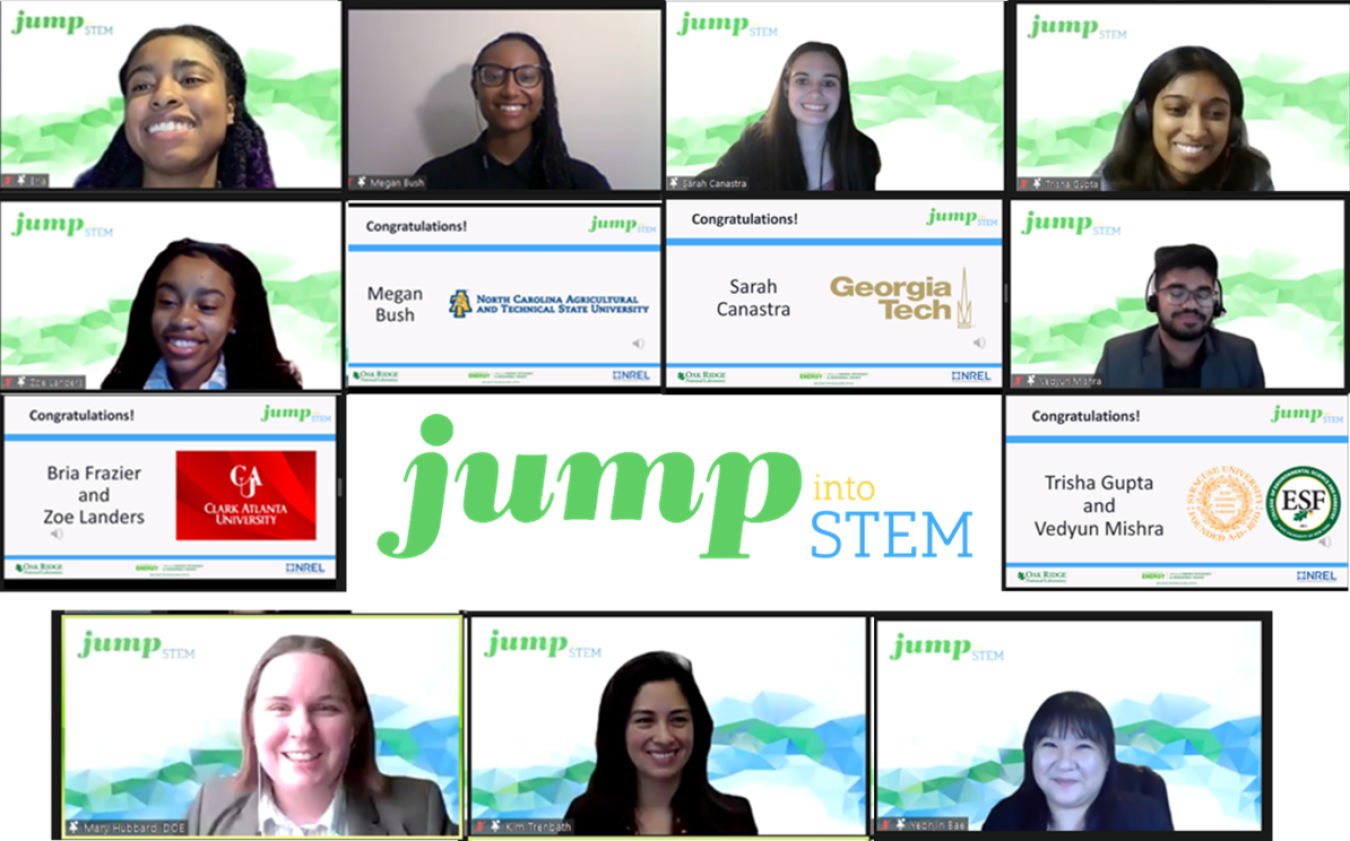The six winning students from four college teams have been offered paid 10-week summer internships at either ORNL or NREL.
February 16, 2021
The winning teams from left to right: Bria Frazier and Zoe Landers from Clark Atlanta University, Megan Bush from North Carolina Agricultural and Technical State University, Sara Canastra from the Georgia Institute of Technology, and Trisha Gupta and Vedyun Mishra from Syracuse University and SUNY College of Environmental Science and Forestry.
Bottom row: JUMP into STEM Management Team of Mary Hubbard of DOE’s Building Technologies Office, Dr. Kim Trenbath of the National Renewable Energy Laboratory, and Dr. Yeonjin Bae of the Oak Ridge National Laboratory.
..................................
The Department of Energy’s (DOE) Building Technologies Office (BTO) announced the winners of the annual building technologies competition, JUMP into STEM, at the virtual finals hosted by the National Renewable Energy Laboratory (NREL) January 28-29.
Four winning teams were announced by Mary Hubbard, BTO's Technology-to-Market manager:
- Clark Atlanta University’s Bria Frazier and Zoe Landers, “Triboelectric Floor Generator System”
- Georgia Institute of Technology’s Sarah Canastra, “Load Shifting with Smart Water Heaters: Conservation without the Cold Showers”
- North Carolina Agricultural and Technical State University’s Megan Bush, “Solar Powered Light Pipe with Integrated LED Lamps”
- Syracuse University and SUNY College of Environmental Science and Forestry’s Trisha Gupta and Vedyun Mishra, “Enabling the Proliferation of Energy Auditing”
“We are so excited to see our young, passionate students engaging in science, technology, engineering and math,” BTO Director David Nemtzow said. “These are the experts of the next generation. Programs like JUMP into STEM keep BTO and DOE at the forefront of the effort to build a new American infrastructure and clean-energy economy.”
The national competition, co-sponsored by Oak Ridge National Laboratory (ORNL), is open to undergraduate and graduate students. The six winning students have been offered paid 10-week summer internships at either ORNL or NREL. The program presents three new challenges during the fall semester, asking students to provide a novel contribution to a particular area of building science, balancing innovation with technical feasibility and market conditions. This year, the challenges were 1) Advanced Building Construction Methods, 2) Building Energy Audits for Residential or Commercial Buildings, and 3) Grid-Interactive Efficient Buildings (GEB), and the winning teams represent all three of the challenges.
“It was really great to meet other peers and professors that are just as passionate about building science and technology as I am,” said Anuradha Kadam, a student competitor from the New Jersey Institute of Technology. “This program has opened my eyes to the many possibilities of careers and research topics within this field and has given me the experience and network needed to begin developing a career in building science.”
This 2020-2021 program year had the largest field of student projects to date. A total of 49 ideas were submitted from 144 different students representing 29 different schools. Nineteen students from 11 teams from across the country competed at the final event. The competition also featured its first industry sponsorship, with the Clayton Homes Building Group contributing to the final event.
Organizers are optimistic about the continued growth of the program. “The final competition was very successful. Although it was a virtual event this year, there was excellent participant engagement throughout both days of the competition. Hopefully, next year we can host the final competition in person again at ORNL,” said Dr. Yeonjin Bae, a member of the JUMP into STEM management team.
In addition to the excellent student presentations, the final event featured an interactive career panel, casual and formal networking sessions for students and professors, and virtual tours of ORNL and NREL. Dr. Nikitha Radhakrishnan, a technical advisor for DOE’s BTO and a research engineer at Pacific Northwest National Laboratory, as well as one of the final event judges, said that she “loved the ideas the students brought forth—complex ideas with great practical feasibility.”
“The JUMP into STEM competition is evidence of a future with a balanced and diverse workforce that is capable of solving climate challenges,” said Dr. Kim Trenbath, the acting innovation lead for systems technology research and development in the Buildings and Thermal Sciences Center at NREL, and a member of the JUMP into STEM management team. “I’m proud that we are able to bring these talented minds together in a student competition. Teams with diversity of thought and background are needed to create solutions and processes that are effective, yet at the same time equitable.”
Since 2018, JUMP into STEM has sought to inspire the next generation of building scientists by emphasizing creative ideation and diversity in the field. JUMP into STEM encourages teams with an interdisciplinary mix of majors and representation by students from backgrounds that are underrepresented in STEM. This goal is shared by members of our “Professor Team” who include the JUMP into STEM competition in their classrooms for a grade. This year, the team included 28 professors from colleges and universities across the country. Dr. Olu Olatidoye from Clark Atlanta University has brought multiple winning teams to the JUMP into STEM final events, and says that the JUMP into STEM program is a “great opportunity for students to work on real-life problems in building science and technology” and “will impact these students for life!”

